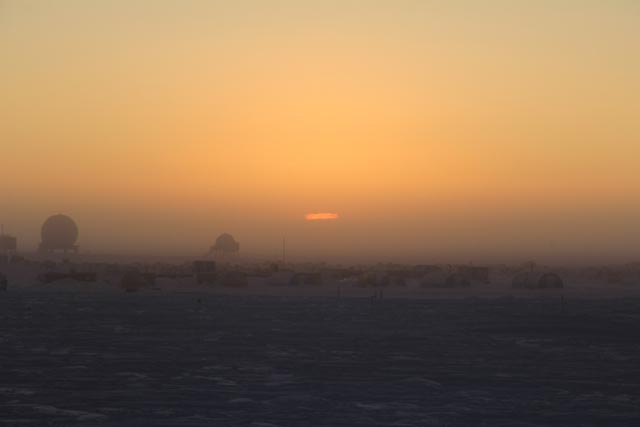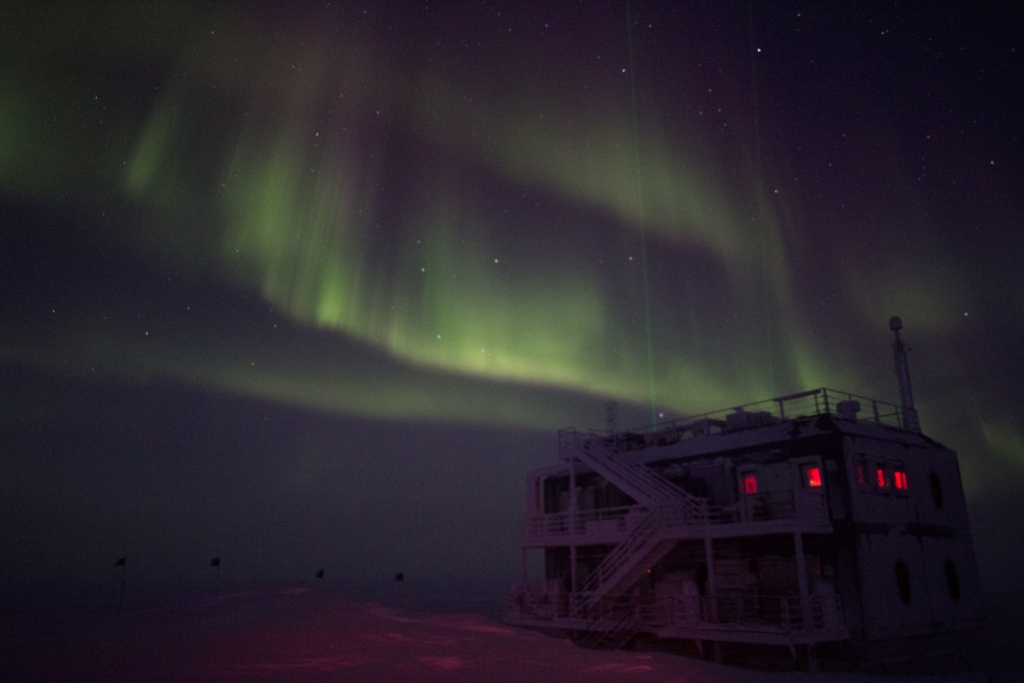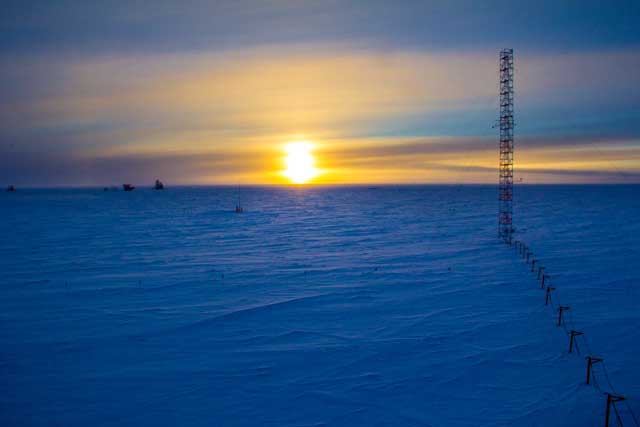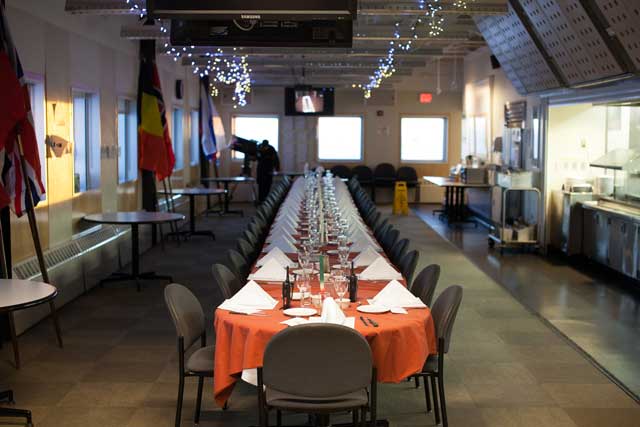|
South Pole Station Archives - 2014 Summer crew arrives in November and gets right to workDecember 4, 2014
South Pole Station had its share of frustrations this year in getting the summer field season underway. Bad weather at McMurdo Station kept south-bound travelers in Christchurch, New Zealand, and a second log jam appeared at McMurdo itself. Poor visibility at South Pole then pushed “first flights” back, disrupting schedules and altering plans. 
Photo Credit: Dean Hancock
An Air Force C-17 makes a pass over the South Pole Station before carrying out an airdrop mission.
But this is the sort of thing that one has to expect in Antarctica. This place is as unpredictable as it is hostile. Most of the Pole-bound travelers took the delays in stride, confident in the knowledge that it was just a matter of time. When skies finally did clear, they did so with a vengeance. Flights brimming with staff and cargo became the rule rather than the exception almost immediately. Weary winter-overs were understandably glad to see their reliefs stepping off the LC-130s, orange bags in hand and enthusiastic about finally making it to “90 South.” Hugs were exchanged among many old hands, and stories of past seasons recounted. Then the hand-over began. The delay in flights meant that the transition from winter to summer crews would be compressed somewhat. But both groups rose to the occasion and focused on what needed to happen to prepare the station for the summer season. By Nov. 17, most of the station’s personnel had settled into something of a routine. On that very evening, many stepped outside to watch as a U.S. Air Force C-17 air-dropped bundles into the station’s summer drop zone. The aircrew’s aim was good, and the packages drifted on their parachutes to within 100 yards from the targets. 
Photo Credit: Dean Hancock
Large piles of snow mark area where the heavy equipment operators are clearing winter drifts around the Dark Sector.
The exercise is done every year so that both aircrews and station staff can remain proficient at the process. It was fun to watch, and reassuring to see the exercise go off so smoothly. Another sign of summer appeared in the form of large piles of snow. They are being built by the station’s heavy equipment operators as they clear roads and restore access to outbuildings. Those parts of the station that are allowed a winter’s nap are being nudged awake. The last few days have seen something of a change on station. Many here seem to be talking less about chaotic travels or the rush to complete an abbreviated turn-over, and more about routine matters and what lies ahead. It would seem that South Pole Station’s summer crew has cleared the cobwebs, and set a course for the season that lies ahead. South Pole finally sees the lightOctober 17, 2014
The skies were mostly clear above the South Pole Station leading up to sunrise, producing beautiful pinks and oranges, as well as a great view of how atmospheric ducting can produce lines of fire in the sky. Atmospheric ducting is a phenomenon where electromagnetic waves are bent by atmospheric refraction, allowing an observer to see objects that are technically below the horizon. We were also treated to the famous green and blue flashes and mirages that made parts of the ice look like rivers of fire. Those of us who saw them found ourselves staring and competing for a better look through the binoculars. The South Pole, due to its extreme southerly location on the planet, experiences one sunrise and one sunset each year, leading to six months of light and six months of twilight and darkness. The station celebrated sunrise with a dinner on Sept. 20. The food was outstanding, and the kitchen staff made delicious mango and potato drinks. The food and sky weren’t the only attractions though. The 2015 South Pole marker was unveiled to the station, and everyone agrees that machinist Matt Kruhn did a fantastic job. Preparations for the summer season are underway. Bathrooms and berthing spaces that were closed during the winter are gradually coming back on line, along with the airplane fueling station. The runway is also being prepped for our first plane, due at the end of October. Dawn beginning to break at South PoleSeptember 11, 2014
Despite the long winter, isolation and close quarters, life at Amundsen-Scott South Pole Station When not working, we’ve managed to keep ourselves busy making camping stoves out of recycled cycled soda cans, watching a Star Wars movie marathon and marveling at the clear skies that have given us spectacular auroras, flawless displays of the Milky Way and even this winter’s super moon. Personnel involved in the facilities and maintenance of the station also set up a putt-putt golf party called Putt Putt Pole. After making custom South Pole-themed rules, they used recycled wood, PVC pipe and yoga mats to make a challenging nine-hole course in the gym. The fun and entertainment included wigs and karaoke-style singing. Everyone that attended thought the party was great, and it’s been said that it was “one of the best social events of the winter.” The month ended on a bit of a “warm” note in terms of temperatures, as three daily record highs fell. iv style="margin: 0in 0in 6pt">On Aug. 26, the maximum daily temperature of minus 33.3 degrees Fahrenheit (minus 36.3 degrees Celsius) eclipsed the record of minus 34.8F (minus 37.1C) set in 1989. It hit minus 40.9F (minus 40.5C) on Aug. 28, breaking the record of minus 44.5F (minus 42.5C) from 1996. Finally, on Aug. 30, the temperature peaked at minus 34.4F (minus 36.9C), beating out a record going back to 1967 when it reached minus 38.0F (minus 38.9C). All of that pales in comparison to the biggest topic of conversation this past month – the ever-increasing sunlight on the horizon. Each day the sun’s glow grows, stars disappear, and the night sky changes into summer blue. Most on station are looking forward to the sun’s return, which means working on the long list of items needing to happen before the station can be accessible to the world again and before most of us begin a well-deserved vacation. For some, though, saying hello to the sun means saying goodbye to the darkness, auroras and thousands of stars that make the Antarctic night sky unlike any other sky in the world. Truly, a bittersweet moment. Station personnel remain ready to respond to emergencies with monthly drillsAugust 15, 2014
South Pole Station’s 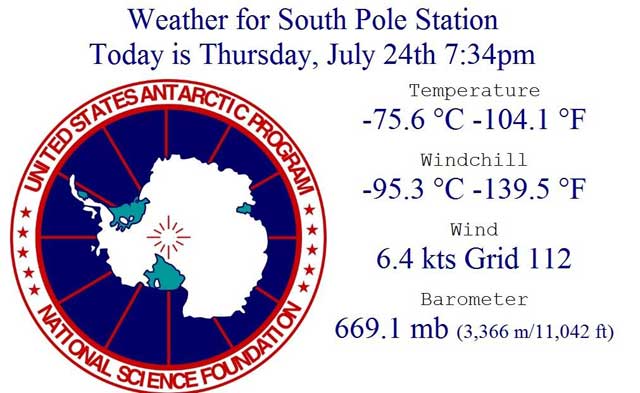
Screen shot at South Pole Station of the day in July that it got below minus 100 degrees Fahrenheit.
The night’s festivities included a beanbag toss and horseshoe game, good music and good company. We even had special guest appearances by Johnny Cash and King George III, although one was cardboard and the other was a piñata. We enjoyed clear skies overhead during the last few weeks of the month, giving the local photographers many ‘last’ opportunities to capture auroras and the starry sky before the sun’s light becomes too dominant. The clear skies and low winds also helped the station reach its lowest temperature yet this winter: minus 105.3 degrees Fahrenheit (or minus 76.3 degrees Celsius). 
Photo Credit: Derek Sargent
“Victims” take their places during a mass causality incident drill in the station’s emergency power plant.
The long isolation of the station during the cold winter months means we have to rely on ourselves for any emergency. It’s a requirement for winter-overs to participate on at least one of three emergency response teams – logistics, fire and medical. The logistics team supports the fire and medical teams by providing tools, additional protective equipment, and personnel to help where needed. The fire crew is the first team to respond to an emergency, whether to investigate or fight a fire, clean up spills or perform a rescue if necessary. The medical team, led by two licensed medical professionals, works with medical first-responders and others to stabilize and treat potential victims. Each team trains independently once per week. Once per month, they all collaborate on a simulated emergency drill. In July, station personnel worked together for a mass causality incident drill. The simulated explosion and glycol (fluid) spill in the emergency power plant was designed to push each team to its limits by reducing available personnel and resources. Each team worked together to respond in a timely manner. Feast and festivities mark Midwinter Day at South Pole StationJuly 18, 2014
June was an exciting month at Amundsen-Scott South Pole Station 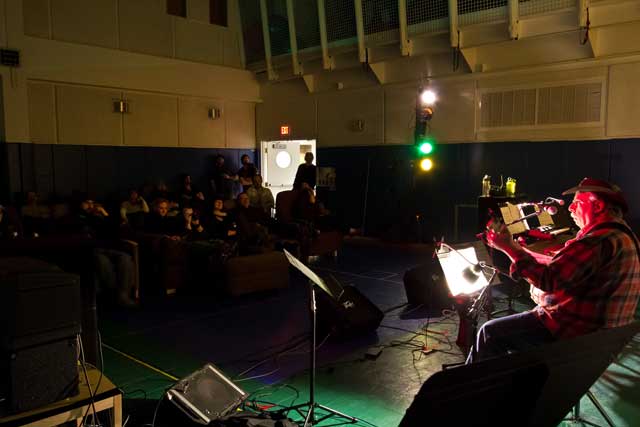
Photo Credit: Joe Phillips
South Pole Station shop foreman Jack Sharp plays the banjo in the gym for Midwinter Day.
“It's all downhill from here,” said Shelly Finley, South Pole Station winter site manager. “It’s the beginning of the end. … Sunrise will be here before we know it.” To celebrate this winter milestone, members of South Pole Station came together and enjoyed a delicious meal. The meal began with appetizers and midwinter presents. The Star Wars and Star Trek toys put huge grins on the faces of quite a few people. 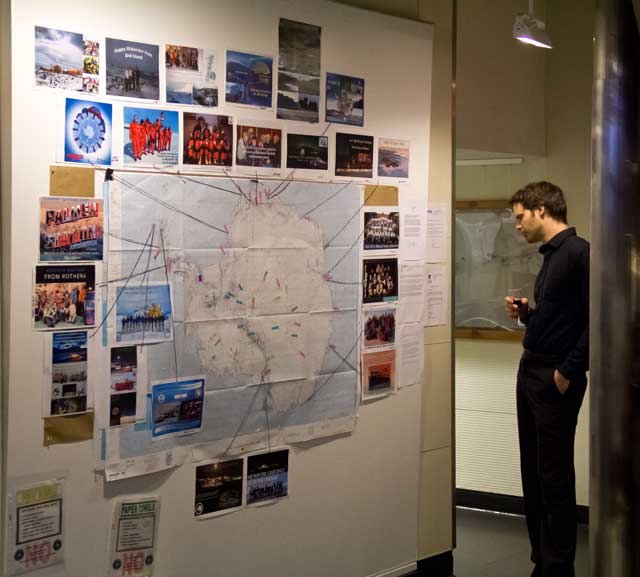
Photo Credit: Joe Phillips
Research associate Neal Scheibe looks over Midwinter Day greetings from research stations across the continent..
Following the appetizers, we took our seats and settled into a delicious butternut squash bisque that was topped with crème fraiche, cranberries and brioche croutons. The entrée followed, and the choices were filet mignon, lobster ravioli or vegetable timbale. Desert was a chocolate soufflé. Once again, the kitchen staff went out of its way. Everyone left the table with a full belly and a smile. To help out the kitchen staff – and to make the occasion more memorable for everyone – a number of the station’s crew volunteered their time to help set up, serve and clean up. During the digestion period, a few members of the station held an open mic night for everyone in the gym. The show opened with Jack Sharp telling a few hilarious jokes and giving us a few tunes on the banjo. Ray Sundby then took to the stage and sung a few songs before the main event, The Duck Pruppets, took the stage using a variety of instruments. South Pole honors veterans on Memorial DayJune 13, 2014
On Monday, May 26, South Pole Station 
Photo Credit: Clair Vonhandorf
The American flag at the South Pole, with an aurora shining in the sky above.
After a brief overview of the history of Memorial Day by former U.S. Marine Corp Sgt. Charles Leachet, a heartfelt presentation was played in the station cafeteria, also known as the galley, honoring those in service who died. Particular attention was given to friends and family of station personnel, and those lost in Antarctica helping to establish the present-day U.S. Antarctic Program Throughout the day, a memorial was displayed in the galley showing the names, rank and service of these military service members. There are eight former and/or retired members of the U.S. military at South Pole right now. These military members are Capt. Richard Young, US Army, Ret.; CPO Robert Hase, USCG, Ret; Stephanie Olcott, U.S. Navy, Ret; Sgt. Charles Leachet, USMC; Sgt. Chet Waggoner, U.S. Army; Cpl. Benjamin Norman, USMC; Spc. Christian Clark, U.S. Army/Army National Guard; and Spc. Bill Morris, U.S. Army. 
Photo Credit: Joe Phillips
A poster and place settings on display on Memorial Day at the South Pole Station in honor of those who were lost while serving their country.
They all use skills he or she learned while serving to help maintain scientific and station operations. For example, Hase, Norman and Clark use knowledge and experience learned while serving to ensure the station receives water, electricity and heat from our power plant. Waggoner is one of our satellite engineers. He uses a variety of skills learned while serving in the U.S. Army to maintain satellite communications and our much-appreciated Internet connection. Olcott is one of our station meteorologists and she uses the skills she learned as a U.S. Navy meteorologist to launch weather balloons to take weather observations, which are also used in forecasting models. In June, we’ll spend time each week remembering the 70 million military members who fought in World War I. Also, in June, we will celebrate midwinter, the significant halfway milestone for everyone here. Short 'heat wave' hit South Pole in April as aurora season gets under wayMay 23, 2014
When you think about Antarctica or South Pole, most people only think about how cold it gets here. But much like everywhere else in the world, it does “heat up” every now and then. When it does, we have the pleasure to announce when “heat waves” break records. This past April, we broke three daily maximum temperature records: On April 15, we reached minus 32.6 degrees Fahrenheit (previous record set in 1965 was minus 36.04F); April 16 we reached minus 29.9F (previous record set in 2002 was minus 34.6F); and April 17 we reached minus 25.7F (previous record set in 2002 was -30.1F). These warm temperatures were accompanied by abnormally thick clouds that blocked the lunar eclipse and limited the number of ozone moon observations from NOAA’s Atmospheric Research Observatory Temperature records weren’t the only records broken this month. The wind was howling, building up snow around the buildings and limiting access to the geographic South Pole. We broke three wind speed records this month: April 6 saw a peak wind speed of 30 knots (previous record set in 2009 was 20 knots); April 6 also gave us our highest average wind speed of 19.3 knots (previous record set in 1970 was 19.2 knots); and on April 13, we saw 34 knots, breaking the previous record of 33 knots set in 2013. Despite all the windy and cloudy days, we got our first glimpse of what everyone’s been waiting for this winter – the aurora australis! An active sun and the sky being clear at just the right time gave us some impressive displays more than once. Our resident aurora and photography expert, Robert Schwarz, is teaching everyone why auroras happen here, the best ways to photograph them and the stars behind them, and what to expect in the sky later this winter. Sun sets in March, heralding six months of winter darknessApril 11, 2014
March was an extremely exciting time at South Pole Station Researchers using the Background Imaging of Cosmic Extragalactic Polarization (BICEP) 2 telescope The evidence collected from BICEP2 at the South Pole suggests that physicists have spied the gravitational waves, ripples in space-time, that theorists believe would still be detectable in the cosmic microwave background nearly 14 billion years after the Big Bang This wasn’t the only big news at South Pole. This announcement was literally shadowed by the annual setting of the sun. Throughout the month, the sky got darker and darker. While the sun was still above the horizon, we were graced by mirages called fata morgana, tumbleweed-like blowing snow called yuki marimos, and, of course, the amazing sunset colors and the dark shadow of the Earth. Unfortunately, though, the clouds rolled in right around the time green flashes would have been visible. On March 22, a flag ceremony was held at the ceremonial South Pole and ended with the flags being brought inside for the winter. The replacement flags are on display in the dining area and will be placed outside around sunrise – about six months from now. The flag ceremony was followed by our fantastic sunset dinner. The entrée options were delicious: poached halibut with pistachio, potato gnocchi, malt vinegar, roasted onions and pea puree; pork confit with bacon marmalade, fennel, apple and potato sauté; caribbean cake with a banana curry sauce. The meal was capped off with a chocolate lava cake. The galley staff truly did outdo themselves. Now that twilight is here, everyone is anxiously awaiting the coming night sky. Night photography is a common conservation in the galley and everyone is looking to the experts for advice on the best ways to capture the coming auroras and stars. South Pole begins winter isolationMarch 7, 2014
Winter has officially begun at South Pole Station The last LC-130 left on Feb. 14 and the last Twin Otter left on Feb. 19. New and old friends said their goodbyes and wished each other safe travels or luck for the coming months. For the past couple months, we’ve been talking about and hearing from previous winter-overs about the joys and hardships that come with winter at South Pole. Despite the disappointment when the LC-130 Leading up to the end of the 2013-14 summer, buildings away from the main station started closing. There was a mad dash to get cargo in and out for science groups, transition tasks and say our goodbyes. During the winter season, South Pole is essentially isolated from the rest of the world because the extreme temperatures prevent planes from landing. Because of this isolation, finding ways to entertain ourselves outside of our working schedules is an important task. Since we all knew this was coming, we all prepared and have started creating habits: working out regularly, starting to learn other languages, attending weekly volleyball and badminton games, or teaching classes like astronomy, Jiu-jitsu, dance or fencing. One of the best and most important things about winter is that the community members help out where they can. Station personnel work together to clean the station weekly (commonly called ‘House Mouse’) and regularly spend time in the dish pit to help our wonderful galley staff. We even have had some volunteers take up the greenhouse responsibilities, and are now thoroughly versed in vegetable growing techniques and the hydroponics system. The summer was filled with unforgettable memories and many great people. Each winter crewmember appreciates the work they did and the information that was passed along. Research, maintenance projects wrap up in JanuaryFebruary 14, 2014
Several scientific equipment upgrade and maintenance projects were completed at South Pole Station 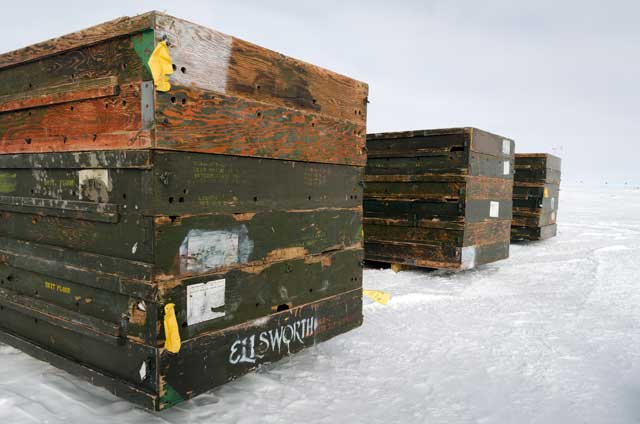
Photo Credit: Peter Rejcek
Flooring for the South Pole Station Jamesways dates back to the 1950s IGY era.
No new experiments were installed this year, though some preparation work began for a couple of projects slated to start in 2014-15, including an ice-core project and a collaborative project using the South Pole Telescope Work also continued on a number of station maintenance projects, including the widening of the utility corridor, or utilitdor, that runs underneath the South Pole Station. That project involved using an electric chainsaw to cut out blocks of ice from the ceiling and side of the utilidor, which is a tunnel burrowed out of the snow. The blocks were then hauled to the surface by sled. Work also began on dismantling some of the Jamesway buildings that comprised Summer Camp, a collection of tented buildings that used to house additional station staff and scientists before the South Pole population was reduced to about 150 people to accommodate the station that was dedicated six years ago. 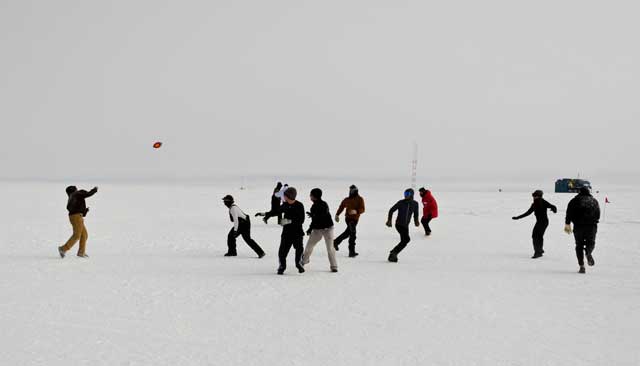
Photo Credit: Peter Rejcek
People at South Pole Station enjoy a game of football in relatively mild summer conditions of about minus 10F.
The wood flooring for at least some of the Jamesway buildings dates back to the 1950s, with the word “Ellsworth” stenciled on some of the platforms. Ellsworth Station was one of the seven International Geophysical Year The weather started to cool off, signaling the beginning of winter. The high in January was a relatively balmy minus 5.3 degrees Fahrenheit at mid-month, which allowed for some outdoor recreation like football and ultimate frisbee. By the last day of January, the low had hit minus 41.3F. The remainder of the summer crew was scheduled to leave by Feb. 14, leaving a winter-over population of about 41. |
Home /
Around the Continent /
South Pole Station Archives - 2014
"News about the USAP, the Ice, and the People"



For USAP Participants |
For The Public |
For Researchers and EducatorsContact UsU.S. National Science FoundationOffice of Polar Programs Geosciences Directorate 2415 Eisenhower Avenue, Suite W7100 Alexandria, VA 22314 Sign up for the NSF Office of Polar Programs newsletter and events. Feedback Form |

